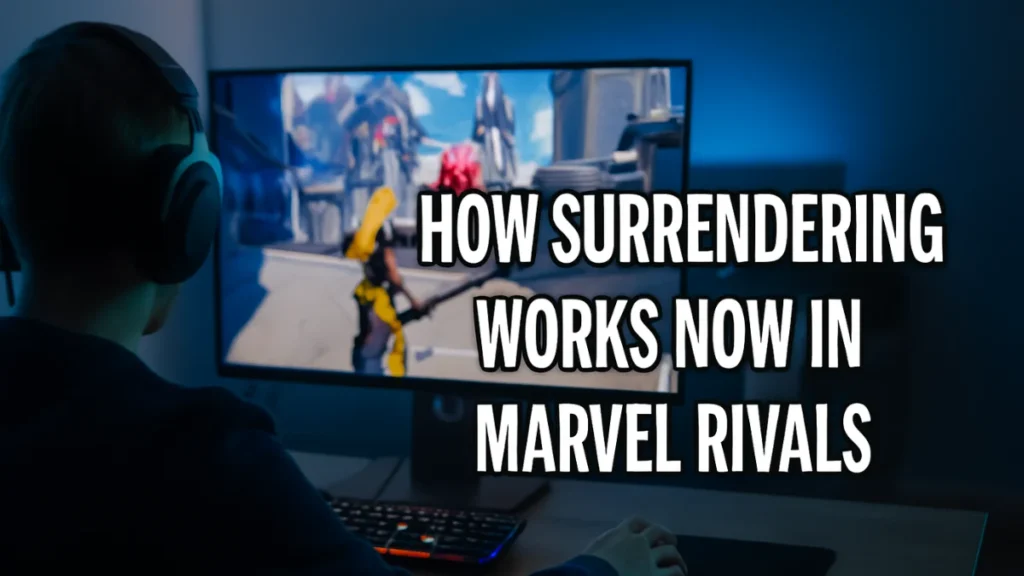Marvel Rivals just made it easier to end bad matches early—and that’s got players talking. With its June 26 update, the game’s surrender system now works differently, especially in ranked mode. While this helps players stuck with smurfs or teammates who throw the match, it could also lead to more early quits—even in games that aren’t fully lost yet.

Why NetEase Changed the Surrender Rules
Before the patch, surrendering in Marvel Rivals required every single teammate to vote yes. That meant even if five players wanted to quit, one holdout could keep the match going. It was frustrating—especially in ranked play, where staying in a doomed match could hurt your rank or waste your time.
Ranked players have been especially frustrated, since there’s always been a risk of losing points even when a teammate is trolling or just gives up. NetEase tried softening rank penalties before, but most players didn’t think it really helped.
Now, the surrender system adjusts based on how many players are still on your team. Here’s how the new vote system works:
| Team Size | Votes Needed to Surrender |
|---|---|
| 6 players | 5 votes |
| 5 players | 4 votes |
| 4 players | 3 votes |
| 3 players | 3 votes |
| 2 players | 2 votes |
This new setup fixes that problem. Before, even if teammates had left the match, everyone still had to vote yes to surrender—which made no sense. Now the vote count adjusts based on how many players are left.
Why the New Surrender Vote Makes a Difference
This update is part of NetEase’s bigger effort to deal with disruptive behavior. In Season 2 (Hellfire Gala), players have seen more issues with teammates sabotaging games on purpose or smurfs making matchmaking unfair. Letting teams vote to end those games faster is a smart way to avoid more damage to your rank—and your time.
Ultron’s arrival, along with Emma Frost earlier in the season, has really shaken up team compositions. That’s led to more experimental matches—and sometimes, a quick surrender is the smartest option when the strategy just isn’t working.
Even better, Marvel Rivals doesn’t lock players into specific roles. You can switch between tank, damage, or support during the match. That still gives teams the chance to change their approach mid-game—so surrendering isn’t the only way out. But if nothing’s working, the option is there.
Why Some Players Love It—and Others Don’t
There’s a clear upside here: no more being stuck because one person refuses to surrender. But not everyone sees it as a win.
Some players are worried that this could lead to surrender abuse. Teams might give up too soon, even when there’s still a shot at turning things around. In games like Marvel Rivals—where strategy swaps and hero counters can shift the tide—a comeback is often just one decision away.
NetEase hasn’t said much yet, but they are keeping an eye on how players use the new surrender system. Right now, there’s no cooldown or limit on how many times a team can try to vote in a match, which might be something they tweak later.
There’s one odd thing, though—this whole surrender system still isn’t in quick play. That’s left some casual players stuck in lopsided games with no way out if a teammate goes AFK or trolls the match.
Other Changes in the June 26 Patch
The June 26 update didn’t just bring surrender changes. It also added two new skins:
- Thor – Majestic Raiment
- Punisher – Daredevil: Born Again
These skins dropped in the shop later the same day, starting at 10 PM ET.
One of the key fixes brings back Doctor Strange’s ability to earn Ult charge when he scores tricky portal kills—something that broke in a previous update. Magneto and Mister Fantastic also had weird collision and animation bugs cleaned up, which should make them feel smoother to play. Iron Fist and Winter Soldier also received minor fixes to clean up ability interactions.
Final Thoughts
Marvel Rivals‘ surrender update is a step in the right direction for players who’ve dealt with lopsided or ruined matches. It gives teams more control, especially in competitive play. But whether this change helps or hurts the game long-term will depend on how the community uses it.
If players start quitting too soon, it might encourage bad habits. But for now, it’s a welcome tool—especially for anyone stuck with toxic teammates or matches that spiral out of control.
Season 2 is winding down, and with Season 3 likely coming soon, this surrender system could become a big part of how players approach ranked games going forward.
Read More:
Overwatch 2 G.I. Joe Crossover Explained: Skins, Reactions & Why It Works
Ninja Time Codes (June 2025): Get Free Clan, Element & Family Spins
Anime Last Stand Codes June 2025: All Working Codes for Rerolls & Pearls
Condition Overload Warframe Guide: How It Works and Why It’s Broken on Some Weapons
How to Remove Ticks in Peak: Solo and Co-op Guide for Poison Removal

